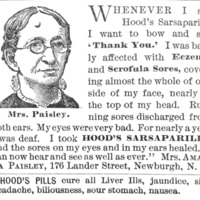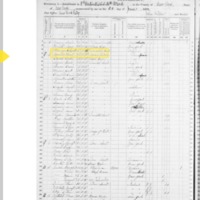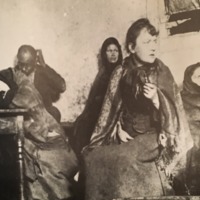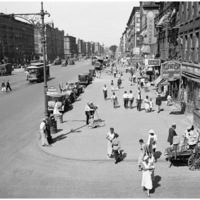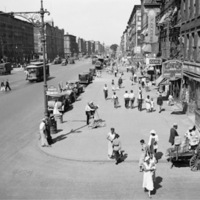Browse Items (160 total)
Sort by:
Harper's Weekly, Journal of Civilization, 1858
One piece of the weekly that stood out to me as I read along, was the ad addressed to the companies and business owners in other words aristocracy. To me it was strange to see space taken up to advertise the weekly’s offerings because in today’s…
Higher Educational Ideals in 1890's
Talks about the education that is most useful and beneficial. Determines college as being well worth the effort and then goes into determining the best course of study. Discounts the traditional subjects such as rhetoric, Latin, classics, ect.…
Historic New York Transportation
A brief yet informative web page on the history of public transportation in New York City. The transportation services covered range from omnibuses (present in many stories about the period including Henry James' Washington Square, and Steven…
Tags: elevated train, New York, omnibus, subway, transportation
Hood's Sarsaparilla Pills Ad
This item is an advertisement for Hood’s Sarsaparilla pills which treat “all liver ills”, jaundice, sick headache, biliousness, sour stomach, and nausea. In the advertisements a woman, Amanda Paisley, tells in depth, of her grotesque experience with…
House of Prostitution
Census workers did an in-depth survey on American households and published their findings. In the column on “profession, occupation or trade”, certain houses of prostitution. The specific households of the prostitutes were published and were 114 West…
Tags: Maggie, prositution
How Destruction of Trees Affects the Rain, Harpers Weekly, 1856
How the Destruction of Trees Affects the Rain is an article that talks about the long run impacts of the unchecked destruction of trees and forests. The readers of the article could be people who have probably seen the impact of brutality to the…
Tags: Environment, Harpers Monthly
Husband-Hunting
“Husband Hunting” from the Miscellany section of “Harper’s Weekly” is an excerpt from Jane Eyre a novel written by Charlotte Bronte in 1847. This excerpt refutes that women should live their lives for men. The author shows that women should show…
Tags: gender roles, James, women
Immigrants at Ellis Island in 1908
This image of men, women, and children at Ellis Island in 1908 portrays the first-hand experience of newly arriving immigrants. Their clothing appears to be clean, in good condition, average, and not fancy. It seems the clothing is…
Tags: 1900s, Ellis Island, Immigrants, New York City
In a Dive
The image depicts a black man and several white women sitting in a beer dive. One woman is slumped, sleeping at a table. The patrons’ clothing is tattered or in disrepair and the room appears plain and unadorned. Maggie’s neighborhood contained…
Tags: 1890s, alcohol, beer dive, How the Other Half Lives, Jacob Riis
Jewish Immigrants Coming to America
The image shows Jewish immigrants en route to America, probably via Ellis Island as it served as the main hub for the immigration of European Jews during the time. The image not only shows Jewish migrants but how the US would start becoming a melting…
Tags: 1890s, Immigrants
Lady America Opens the Gates
On the cover of this issue of The Jewish Immigrant is depicting Lady Liberty standing in front of the Gates to the United States. She is wearing a cap that has the word “America” written on it in Yiddish. This picture is representative of the mass…
Tags: 1900s, Immigration
Laws for Granting Citizenship to Women
"Vos Yede Froy Darf Visen Vegen Birgershaft", which directly translates to "What Every Woman Should Know about Citizenship." The book is written in both Yiddish and English. This information booklet was made in 1926 by the National Council of Jewish…
Lenox Avenue
This photo is an picture of Lenox Avenue in the 1920s. Lenox Ave seems to be a predominately African American area and also very busy and bustling. Lenox Ave is filled with identical buildings, all of which have the same height, same width, and…
Tags: 1920s, Fire!!, Harlem Renaissance, Lenox Avenue
Lenox Avenue Clubs
Lenox Avenue was the most popular street in Harlem during the Harlem Renaissance. Lenox Avenue served as a major hub for African American culture during the Harlem Renaissance. Here, clubs and restaurants sprung up that featured some of the most…
Lenox Avenue: A Symbol of Hope
“We have to-morrow
Bright before us
Like a flame”
(663, Hughes)
This quote from one of Langston Hughes’ many poems expresses the hope that African Americans have during the time of the Harlem Renaissance. Hughes refers to this bright future as…
Bright before us
Like a flame”
(663, Hughes)
This quote from one of Langston Hughes’ many poems expresses the hope that African Americans have during the time of the Harlem Renaissance. Hughes refers to this bright future as…
Tags: Harlem Renaissance, Hughes, Lenox Avenue




